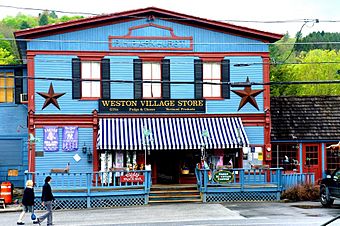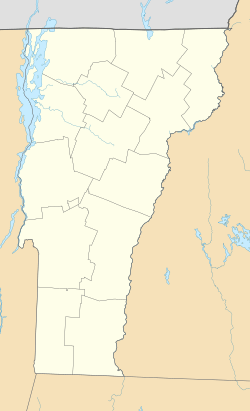Weston Village Historic District facts for kids
Quick facts for kids |
|
|
Weston Village Historic District
|
|
 |
|
| Location | Main, Park & School Sts., Lawrence Hill, Landgrove & Trout Club Rds., Mill Lane & Chester Mountain Rd., Weston, Vermont |
|---|---|
| Area | 62 acres (25 ha) |
| Architectural style | Mid 19th Century Revival, Colonial Revival, Late Victorian |
| NRHP reference No. | 85001934 |
| Added to NRHP | August 29, 1985 |
The Weston Village Historic District is a special area in the heart of Weston, Vermont. It includes the town center and its main village. This district is centered around Farrar Park, which acts like the town's central green space. You can find many different styles of buildings here. These buildings were built from the late 1700s up to about 1935. The district has homes, public buildings, shops, old factories, and churches. It was added to the National Register of Historic Places in 1985 because of its important history.
Contents
Welcome to Weston Village!
A Glimpse into Weston's Past
How Weston Began
Weston is located in southwestern Windsor County. It sits in a quiet valley within the Green Mountains. The town was once part of Andover, which is to the east. However, it was hard to travel between the two places. This was because a mountain ridge separated them. So, Weston became its own town in 1799.
The main village grew where Cold Spring Brook meets the West River. Around 1780, a man named Ezekial Pease built a sawmill here. His original house is still part of a larger home built in the early 1800s. In 1795, Oliver Farrar built a tavern. This tavern faces the park that now carries his family's name. Weston's very first town meeting was held at Farrar's tavern.
Farrar Park: The Heart of the Village
Farrar Park is like the town square or village green. It is a central open space in Weston. The park was officially designed in the 1880s. This was a time when the village was growing and doing very well. It remains an important gathering spot for the community.
Exploring the Historic District
What Does the District Look Like?
The historic district is shaped a bit like the letter "Y". It stretches north and south along Vermont Route 100, which is also called Main Street. It also goes west along Lawrence Hill Road. The northern end of the district is where Vermont 100 meets Chester Mountain Road. The western end is where Lawrence Hill Road meets Trout Brook Roads. The southern edge is just south of Mill Lane. Most of the buildings in this area are wooden houses. They are usually one or two stories tall.
Famous Buildings to See
Right in the center of the village, you'll see the theater of the Weston Playhouse Theatre Company. This is Vermont's oldest performing arts group. There are also several public buildings in the district. These include the town office building, which has a Colonial Revival style. You can also find the Wilder Memorial Public Library here. The old Weston School building is also notable, with its Italianate style. One special brick house is the John Wilder House on Lawrence Hill Road. It was also listed on the National Register of Historic Places in 1983.



